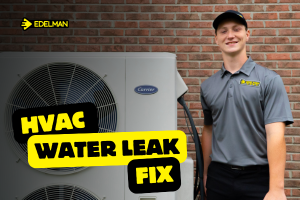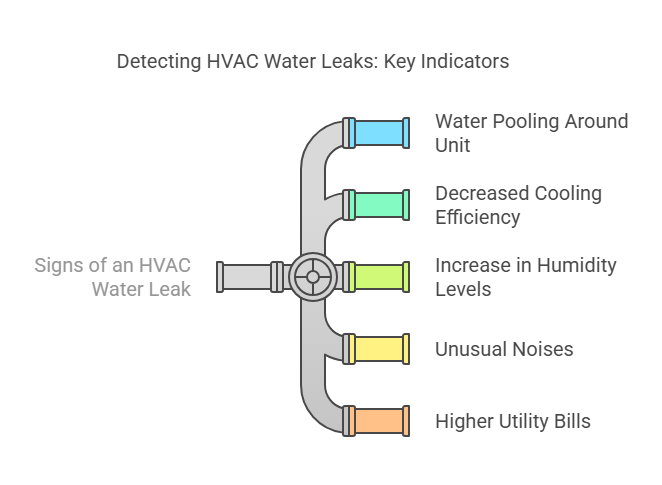Water pooling around your HVAC unit can be scary, but don’t worry – we’ve got you covered. After helping countless homeowners deal with HVAC water leaks, we know exactly how important it is to fix these issues quickly. Let us walk you through everything you need to know about tackling HVAC water leaks, from finding what’s causing them to getting them fixed.
Understanding HVAC Water Leaks: An Overview
What is an HVAC Water Leak?
When your HVAC system cools warm air, it naturally creates condensation. Usually, this water flows into a drain pan and out through a drain line – that’s normal. But when you spot water where it shouldn’t be, something’s gone wrong with this process.
Think of it like this: condensation is actually a good sign – it means your system is doing its job of removing humidity from your home. But when water starts showing up in unexpected places, it’s time to investigate.
Why Addressing Leaks Promptly is Crucial
Finding out why your HVAC is leaking water isn’t just about convenience – it’s about protecting your home and system. Ignoring a leak can lead to:
- Damage to your walls, floors, and ceilings
- Mold and mildew growth
- Higher energy bills from reduced efficiency
- Dangerous electrical issues
- Complete system breakdown
Fixing a small leak today could save you thousands tomorrow. Think of it like a small roof leak – catch it early, and you’ll avoid major headaches later.
Common Causes of HVAC Water Leaks
When your AC starts leaking, several usual suspects might be to blame. Let’s break them down.
1. Clogged Condensate Drain Line
According to Service Champions, blocked drain lines are the number one cause of AC water leaks. These clogs can come from:
- Algae growing in the line
- Built-up dust and dirt
- Outside debris
- Mold accumulation
2. Damaged or Rusty Drain Pan
Over time, drain pans can rust or get damaged, letting water escape into your home. Look for:
- Rust spots
- Cracks or holes
- Pan sitting crooked
- General wear and tear
3. Frozen Evaporator Coil
When your evaporator coil freezes and then thaws, it can create serious leaks. This usually happens because of:
- Blocked airflow
- Not enough refrigerant
- Running the system when it’s too cold outside
- Parts not working right
4. Dirty or Clogged Air Filter
A clogged filter restricts airflow, which can make your evaporator coil freeze up. When that ice melts, it overwhelms your drainage system. It’s such a simple thing to fix, but it can cause big problems if ignored.
5. Broken or Malfunctioning Condensate Pump
Some systems need a pump to remove condensation. When it fails, you might notice:
- Water pooling around your unit
- Strange pump noises
- Water not draining properly
- Complete pump failure
6. Low or Leaking Refrigerant Levels
Low refrigerant can make your evaporator coil freeze, leading to leaks when it melts. Watch for:
- System not cooling well
- Ice forming on refrigerant lines
- Warm air coming from vents
- Hissing sounds
Remember, only certified pros should handle refrigerant issues – it’s not a DIY job.
Identifying Signs of an HVAC Water Leak
Catching a leak early can save you from expensive repairs down the road. Here are the key signs that’ll tell you something’s not right with your system.
Water Pooling Around Unit
The most obvious red flag is water where it shouldn’t be. Look for:
- Puddles near your indoor unit
- Damp spots on nearby walls or floors
- Water dripping from unusual places
- Standing water in the drain pan
Decreased Cooling Efficiency
When your system’s dealing with a leak, you might notice it’s not cooling like it used to:
- Rooms aren’t getting as cool as they should
- Some areas feel warmer than others
- Your system runs longer than normal
- The air coming out isn’t as cold as usual
Increase in Humidity Levels
If your AC isn’t handling moisture properly, you’ll notice changes in your home’s air:
- The air feels sticky
- Windows are getting foggy
- You smell something musty
- Mold starts showing up on walls
Unusual Noises: Hissing or Bubbling
Pay attention to new sounds from your system:
- Hissing that could mean refrigerant escaping
- Gurgling in the drain line
- Water dripping inside walls
- Clicking or splashing sounds
Higher Utility Bills
A sudden spike in your energy bills often means your system’s struggling:
- Your AC’s working overtime to keep up
- Cooling cycles are running longer
- The system’s efficiency is dropping
- Components are working harder than they should
Initial Steps to Take When You Spot a Leak
Found a leak? Here’s what to do right away to keep everyone safe and prevent more damage.
Safety Precautions: Power Off the System
Safety first – always. Here’s your immediate action plan:
- Turn off your thermostat
- Switch off power at the breaker box
- Unplug nearby electronics
- Keep kids and pets away
- Use towels to contain the water
Assess the Leak’s Severity
Take a good look at what you’re dealing with:
- Try to find where the water’s coming from
- Check how much water has collected
- Figure out how long it’s been leaking
- See if it’s constant or comes and goes
- Look for obvious problems like blocked drains
Documenting Damage for Repairs
Before you start fixing anything:
- Take clear pictures of everything
- Write down when you first noticed the problem
- Note any weird sounds or smells
- List any recent changes in how your system works
- Keep your maintenance records handy
This documentation helps repair pros work faster and can be crucial if you need to make an insurance claim.
Remember, while some leaks are DIY-friendly, others need professional help. If you’re not sure what you’re dealing with, it’s better to call an expert than risk making things worse.
DIY Solutions for Fixing HVAC Water Leaks
Ready to tackle that leak yourself? Here’s what you need to know to fix common water leak problems safely and effectively.
Tools and Materials You’ll Need
Grab these items before you start:
- Wet/dry vacuum
- Wire brush or pipe cleaner
- Regular distilled vinegar
- New air filters
- Good quality sealant
- Safety gear (gloves and goggles)
- Reliable flashlight
- Basic tools (screwdrivers, pliers)
Cleaning the Clogged Drain Line
A simple vinegar solution can prevent most drain line problems. Here’s how to do it:
- Find where you can access the drain line
- Pour in a cup of vinegar
- Let it sit for half an hour
- Flush with clean water
- For tough clogs, use a wet/dry vacuum on the outdoor end
Inspecting and Replacing the Drain Pan
If your drain pan’s the problem:
- Look carefully for rust, cracks, or holes
- Give it a good cleaning
- Use sealant on small damage
- Replace severely damaged pans
- Make sure it sits level when you put it back
Replacing or Cleaning Air Filters
Dirty filters can cause big problems. Here’s the fix:
- Switch off your system
- Take out the old filter
- Clean reusable ones thoroughly
- Put in new ones if they’re disposable
- Check the arrows for proper airflow
- Mark your calendar to check monthly
Clearing the Drain Pipe or Tube
Got a clogged pipe? Here’s what to do:
- Locate your drain pipe
- Clear any obvious blockages
- Clean inside with a pipe brush
- Mix equal parts water and vinegar
- Pour it through the pipe
- Test by running clean water through
Remember, while these DIY fixes work for many common problems, some issues need professional help. If you try these steps and still have leaks, or if you’re not comfortable doing the work yourself, call a qualified HVAC tech.
When to Call a Professional
Sometimes DIY just won’t cut it. Here’s when you need to bring in the experts.
Complex Repairs Beyond Basic Maintenance
Call a pro when you see:
- Water getting near electrical parts
- Multiple things going wrong at once
- Strange noises or vibrations
- Water damage in walls or ceiling
- Anything that might void your warranty
Signs the Issue is Refrigerant Related
If you notice these warning signs, you need certified help:
- Ice forming on refrigerant lines
- Warm air coming from vents
- Hissing sounds
- Unusually high power bills
- Inconsistent cooling
Remember: Only EPA-certified pros can legally handle refrigerant. Don’t try to fix these issues yourself.
Persistent Leaks Despite DIY Solutions
Time to call in the experts if:
- Leaks keep coming back
- Water damage is spreading
- The leak’s getting worse
- You find multiple leak sources
- Your system’s performance keeps dropping
Professional HVAC techs bring:
- Advanced diagnostic tools
- Proper certification for all repairs
- Ability to spot hidden problems
- Long-term solutions
- Knowledge to maintain your warranty
Don’t let pride or cost concerns keep you from calling a pro when needed. Sometimes it’s the smartest and most cost-effective choice in the long run.
Preventive Maintenance Tips for Avoiding Future Leaks
The best way to handle HVAC leaks is to prevent them from happening in the first place. Here’s how to keep your system running smoothly.
Regular HVAC Inspection and Maintenance Schedule
Stay ahead of problems with this routine:
- Get professional check-ups twice a year (before summer and winter)
- Do your own monthly visual inspections
- Keep track of how your system’s running
- Save all maintenance records
- Fix small issues before they grow
Regular maintenance, like cleaning your drain line every few months, stops small problems from becoming big headaches. Check out our maintenance plan, the Home Wellness Club!
Tips for Keeping Drain Lines Clear
Keep those drain lines flowing:
- Use vinegar monthly to clean the line
- Check the outdoor drain outlet regularly
- Keep the area around drains clean
- Install a safety float switch
- Consider using algae prevention tablets
These simple steps prevent most drain-related leaks before they start.
Ensuring Air Filters are Clean and Changed Regularly
Following the Department of Energy’s advice, stay on top of filter maintenance:
- Set reminders to check filters monthly
- Keep extra filters on hand
- Consider upgrading to better quality filters
- Clean reusable filters properly
- Change filters more often during heavy use seasons
Clean filters prevent frozen coils and water leaks, making this simple task crucial for your system’s health.
HVAC Water Leak FAQ’s:
1. How much does it cost to fix a leak in the HVAC system?
Repair costs vary depending on what’s wrong:
- Drain line cleaning: $75-150
- New drain pan: $250-500
- Condensate pump work: $150-300
- Evaporator coil replacement: $600-2,000
- Service call and diagnosis: $75-200
Fixing problems early usually costs less than waiting until they get worse.
2. Can I still use my AC if it’s leaking water?
Short answer: you shouldn’t. Running a leaking AC can:
- Create electrical hazards
- Cause bigger system damage
- Lead to costlier repairs
- Create mold problems
- Damage your home’s structure
Better to turn it off until you know what’s wrong and get it fixed.
3. Why is my air conditioner leaking water inside my home?
Indoor leaks can be attributed to several key factors. Drain line problems may occur due to built-up gunk and algae, poor installation, or disconnected lines. Maintenance-related issues include dirty air filters, frozen coils, and damaged drain pans. Installation problems can stem from units that aren’t level, incorrect drain slopes, or poorly set up condensate traps. Environmental factors also play a role, particularly very humid weather, extreme heat, and blocked airflow.
Finding the specific cause helps you fix the problem right the first time.


